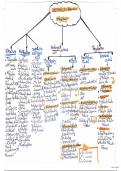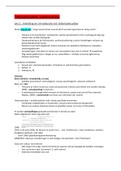Chapter 24: Postpartum Complications
MULTIPLE CHOICE
1. The perinatal nurse’s assessment while caring for a woman in the immediate post birth period
reveals that the woman is experiencing profuse bleeding. What is the most likely etiology for
her bleeding?
a. Uterine atony
b. Uterine inversion
c. Vaginal hematoma
d. Vaginal laceration
ANS: A
Uterine atony is marked hypotonia of the uterus. It is the leading cause of postpartum
hemorrhage. Uterine inversion may lead to hemorrhage, but it is not the most likely source of
this woman’s bleeding. Furthermore, if the woman were experiencing a uterine inversion, it
would be evidenced by the presence of a large, red, rounded mass protruding from the
introitus. A vaginal hematoma may be associated with hemorrhage. However, the most likely
clinical finding would be pain, not the presence of profuse bleeding. A vaginal laceration may
cause hemorrhage, but it is more likely that profuse bleeding would result from uterine atony.
A vaginal laceration should be suspected if vaginal bleeding continues in the presence of a firm,
contracted uterine fundus.
DIF: Cognitive Level: Comprehension REF: p. 607 OBJ: Nursing Process: Diagnosis
2. Which is a primary nursing responsibility when caring for a woman experiencing an obstetrical
hemorrhage associated with uterine atony?
a. Establish venous access.
b. Perform fundal massage.
c. Prepare the woman for surgical
intervention.
d. Catheterize the bladder.
ANS: B
The initial management of excessive postpartum bleeding is firm massage of the uterine
fundus. Although establishing venous access may be a necessary intervention, the initial
intervention would be fundal massage. The woman may need surgical intervention to treat her
postpartum hemorrhage, but the initial nursing intervention would be to assess the uterus.
, After uterine massage the nurse may want to catheterize the patient to eliminate any bladder
distension that may be preventing the uterus from contracting properly.
DIF: Cognitive Level: Application REF: p. 609 OBJ: Nursing
Process: Implementation
3. Which is the most likely cause of late postpartum hemorrhage (PPH)?
a. Subinvolution of the placental site
b. Defective vascularity of the decidua
c. Cervical lacerations
d. Coagulation disorders
ANS: A
Late PPH may be the result of subinvolution of the uterus, pelvic infection, or retained placental
fragments. Late PPH is not typically a result of defective vascularity of the decidua, cervical
lacerations, or coagulation disorders.
DIF: Cognitive Level: Comprehension REF: p. 607 OBJ: Nursing Process: Planning
4. What woman is at greatest risk for early postpartum hemorrhage (PPH)?
a. A primiparous woman being prepared for
an emergency Caesarean birth for fetal
distress
b. A woman with severe pre-eclampsia on
magnesium sulphate whose labour is
being induced
c. A multiparous woman with an 8-hour
labour
d. A primigravida in spontaneous labour
with preterm twins
ANS: B
Magnesium sulphate administration during labour poses a risk for PPH. Magnesium acts as a
smooth muscle relaxant, thereby contributing to uterine relaxation and atony. Although many
causes and risk factors are associated with PPH, the primiparous woman being prepared for an
emergency Caesarian birth, the multiparous woman with 8-hour labour, and the primigravida in
spontaneous labour are not at risk for early PPH.
DIF: Cognitive Level: Analysis REF: p. 607 | Box 24-1 OBJ:
Nursing Process: Planning
, 5. What is the initial priority nursing intervention when a nurse observes profuse postpartum
bleeding?
a. Call the woman’s primary health care
provider.
b. Administer the standing order for an
oxytocic.
c. Palpate the uterus and massage it if it is
boggy.
d. Assess maternal blood pressure (BP)
and pulse for signs of hypovolemic
shock.
ANS: C
The initial management of excessive postpartum bleeding is firm massage of the uterine
fundus. Although calling the health care provider, administering an oxytocic, and assessing
maternal BP are appropriate interventions, the primary intervention should be to assess the
uterus. Uterine atony is the leading cause of postpartum hemorrhage.
DIF: Cognitive Level: Application REF: p. 609
OBJ: Nursing Process: Implementation
6. What is the most objective and least invasive assessment of adequate organ perfusion and
oxygenation when caring for a postpartum woman experiencing hemorrhagic shock?
a.
b. Cool, dry skin
c. Diminished restlessness
d. Urinary output of at least 30 mL/hr
ANS: D Absenc
e of cyanosis in the buccal mucosa
Hemorrhage may result in hemorrhagic shock. Shock is an emergency situation in which the
perfusion of body organs may become severely compromised and death may occur. The
presence of adequate urinary output indicates adequate tissue perfusion. The assessment of
the buccal mucosa for cyanosis can be subjective in nature. The presence of cool, pale, clammy
skin would be an indicative finding associated with hemorrhagic shock. Hemorrhagic shock is
associated with lethargy, not restlessness.
DIF: Cognitive Level: Analysis REF: p. 609 | p. 613
OBJ: Nursing Process: Assessment
MULTIPLE CHOICE
1. The perinatal nurse’s assessment while caring for a woman in the immediate post birth period
reveals that the woman is experiencing profuse bleeding. What is the most likely etiology for
her bleeding?
a. Uterine atony
b. Uterine inversion
c. Vaginal hematoma
d. Vaginal laceration
ANS: A
Uterine atony is marked hypotonia of the uterus. It is the leading cause of postpartum
hemorrhage. Uterine inversion may lead to hemorrhage, but it is not the most likely source of
this woman’s bleeding. Furthermore, if the woman were experiencing a uterine inversion, it
would be evidenced by the presence of a large, red, rounded mass protruding from the
introitus. A vaginal hematoma may be associated with hemorrhage. However, the most likely
clinical finding would be pain, not the presence of profuse bleeding. A vaginal laceration may
cause hemorrhage, but it is more likely that profuse bleeding would result from uterine atony.
A vaginal laceration should be suspected if vaginal bleeding continues in the presence of a firm,
contracted uterine fundus.
DIF: Cognitive Level: Comprehension REF: p. 607 OBJ: Nursing Process: Diagnosis
2. Which is a primary nursing responsibility when caring for a woman experiencing an obstetrical
hemorrhage associated with uterine atony?
a. Establish venous access.
b. Perform fundal massage.
c. Prepare the woman for surgical
intervention.
d. Catheterize the bladder.
ANS: B
The initial management of excessive postpartum bleeding is firm massage of the uterine
fundus. Although establishing venous access may be a necessary intervention, the initial
intervention would be fundal massage. The woman may need surgical intervention to treat her
postpartum hemorrhage, but the initial nursing intervention would be to assess the uterus.
, After uterine massage the nurse may want to catheterize the patient to eliminate any bladder
distension that may be preventing the uterus from contracting properly.
DIF: Cognitive Level: Application REF: p. 609 OBJ: Nursing
Process: Implementation
3. Which is the most likely cause of late postpartum hemorrhage (PPH)?
a. Subinvolution of the placental site
b. Defective vascularity of the decidua
c. Cervical lacerations
d. Coagulation disorders
ANS: A
Late PPH may be the result of subinvolution of the uterus, pelvic infection, or retained placental
fragments. Late PPH is not typically a result of defective vascularity of the decidua, cervical
lacerations, or coagulation disorders.
DIF: Cognitive Level: Comprehension REF: p. 607 OBJ: Nursing Process: Planning
4. What woman is at greatest risk for early postpartum hemorrhage (PPH)?
a. A primiparous woman being prepared for
an emergency Caesarean birth for fetal
distress
b. A woman with severe pre-eclampsia on
magnesium sulphate whose labour is
being induced
c. A multiparous woman with an 8-hour
labour
d. A primigravida in spontaneous labour
with preterm twins
ANS: B
Magnesium sulphate administration during labour poses a risk for PPH. Magnesium acts as a
smooth muscle relaxant, thereby contributing to uterine relaxation and atony. Although many
causes and risk factors are associated with PPH, the primiparous woman being prepared for an
emergency Caesarian birth, the multiparous woman with 8-hour labour, and the primigravida in
spontaneous labour are not at risk for early PPH.
DIF: Cognitive Level: Analysis REF: p. 607 | Box 24-1 OBJ:
Nursing Process: Planning
, 5. What is the initial priority nursing intervention when a nurse observes profuse postpartum
bleeding?
a. Call the woman’s primary health care
provider.
b. Administer the standing order for an
oxytocic.
c. Palpate the uterus and massage it if it is
boggy.
d. Assess maternal blood pressure (BP)
and pulse for signs of hypovolemic
shock.
ANS: C
The initial management of excessive postpartum bleeding is firm massage of the uterine
fundus. Although calling the health care provider, administering an oxytocic, and assessing
maternal BP are appropriate interventions, the primary intervention should be to assess the
uterus. Uterine atony is the leading cause of postpartum hemorrhage.
DIF: Cognitive Level: Application REF: p. 609
OBJ: Nursing Process: Implementation
6. What is the most objective and least invasive assessment of adequate organ perfusion and
oxygenation when caring for a postpartum woman experiencing hemorrhagic shock?
a.
b. Cool, dry skin
c. Diminished restlessness
d. Urinary output of at least 30 mL/hr
ANS: D Absenc
e of cyanosis in the buccal mucosa
Hemorrhage may result in hemorrhagic shock. Shock is an emergency situation in which the
perfusion of body organs may become severely compromised and death may occur. The
presence of adequate urinary output indicates adequate tissue perfusion. The assessment of
the buccal mucosa for cyanosis can be subjective in nature. The presence of cool, pale, clammy
skin would be an indicative finding associated with hemorrhagic shock. Hemorrhagic shock is
associated with lethargy, not restlessness.
DIF: Cognitive Level: Analysis REF: p. 609 | p. 613
OBJ: Nursing Process: Assessment











